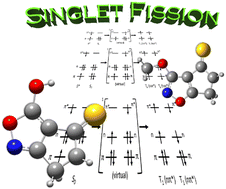Quest for singlet fission of organic sulfur-containing systems in the higher lying singlet excited state: application prospects of anti-Kasha's rule†
Abstract
In this study, we explore the possibilities of the deactivating pathways of organic thione containing systems through first-principles calculations. We particularly pay attention to the second lying singlet excited state, S2, due to its large energy difference from the lowest lying S1 state in the sulfur-containing systems. Several theoretical models including the previously synthesized thiones and the strategically designed molecules are investigated to search for the basic conjugation unit that exhibits the prospect of S2 fission. Various molecular motifs and different substituents are combined to maneuver the relative alignment of the relevant low excited energy states. The results lead us to conclude that the thione derivatives, under rational and delicate molecular designs, may be engineered to possess a sufficiently high S2–S1 energy gap as high as 2 eV and that these systems may exhibit S2 fission to triplet excitons in the red to near infrared region.

- This article is part of the themed collection: 2023 PCCP HOT Articles


 Please wait while we load your content...
Please wait while we load your content...